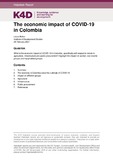| dc.contributor.author | Bolton, Laura | |
| dc.coverage.spatial | Colombia | en |
| dc.date.accessioned | 2021-05-06T15:30:59Z | |
| dc.date.available | 2021-05-06T15:30:59Z | |
| dc.date.issued | 2021-02-26 | |
| dc.identifier.citation | Bolton, L. (2021). The economic impact of COVID-19 in Colombia. K4D Helpdesk Report 971. Brighton, UK: Institute of Development Studies. DOI: 10.19088/K4D.2021.073 | en |
| dc.identifier.uri | https://opendocs.ids.ac.uk/opendocs/handle/20.500.12413/16587 | |
| dc.description.abstract | Available data provide a picture for the macro-economy of Colombia, agriculture, and infrastructure. Recent data on trends on public procurement were difficult to find within the scope of this rapid review. In 2020, macro-level employment figures show a large drop between February and April when COVID-19 lockdown measures were first introduced, followed by a gradual upward trend. In December 2020, the employment rate was 4.09 percentage points lower than the employment rate in December 2019. Macro-level figures from the National Administrative Department of Statistics (DANE) show that a higher percentage of men experienced job losses than women in November 2020. However, the evidence presented by the Universidad Nacional de Colombia based on the DANE great integrated house survey shows that a higher proportion of all jobs lost were lost by women in the second quarter. It may be that the imbalance shifted over time, but it is not possible to directly compare the data. Evidence suggests that women were disproportionately more burdened by home activities due to the closure of schools and childcare. There is also a suggestion that women who have lost out where jobs able to function during lockdowns with technology are more likely to be held by men. Literature also shows that women have lower levels of technology literacy. There is a lack of reliable data for understanding the economic impacts of COVID-19 for people living with disabilities. A report on the COVID-19 response and disability for the Latin America region recommends improving collaboration between policymakers and non-governmental organisations. Younger people experienced greater job losses. Data for November 2020 show 3.3 percent of the population aged under 25 lost their job compared to 1.8 percent of those employed between 24 and 54.
Agriculture, livestock, and fishing increased by 2.8% in 2020 compared to 2019. And the sector as a whole grew 3.4% between the third and fourth quarters of 2020. In terms of sector differences, construction was harder hit by the initial mobility restrictions than agriculture. Construction contracted by 30.5% in the second quarter of 2020. It is making a relatively healthy recovery with reports that 84% of projects being reactivated following return to work. The President of the Colombian Chamber of Construction predicting an 8.4% growth in the construction of housing and other buildings in 2021. | en |
| dc.description.sponsorship | FCDO (Foreign, Commonwealth and Development Office) | en |
| dc.language.iso | en | en |
| dc.publisher | Institute of Development Studies | en |
| dc.relation.ispartofseries | K4D Helpdesk Report;971 | |
| dc.rights.uri | https://www.nationalarchives.gov.uk/doc/open-government-licence/version/3/ | en |
| dc.subject | Economic Development | en |
| dc.subject | Poverty | en |
| dc.subject | Rights | en |
| dc.title | The Economic Impact of COVID-19 in Colombia | en |
| dc.type | Helpdesk | en |
| dc.rights.holder | © Crown copyright 2021 | en |
| dc.identifier.doi | 10.19088/K4D.2021.073 | |
| dcterms.dateAccepted | 2021-02-26 | |
| rioxxterms.funder | Default funder | en |
| rioxxterms.identifier.project | Default project | en |
| rioxxterms.version | VoR | en |
| rioxxterms.versionofrecord | 10.19088/K4D.2021.073 | en |
| rioxxterms.funder.project | 9ce4e4dc-26e9-4d78-96e9-15e4dcac0642 | en |

